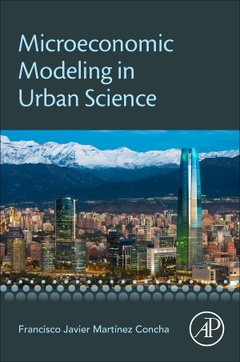Description
Microeconomic Modeling in Urban Science
Author: Martinez Concha Francisco
Language: English
Subjects for Microeconomic Modeling in Urban Science:
Keywords
Agglomeration economies; Allocation equilibrium process; Benthamite social welfare function; Bid rent theory; Bid-choice model; Big data; Capitalization; Central business district; Choice model; Cobb-Douglas parameter; Cobb-Douglas technology; Cognition revolution; Discrete random utility theory; Double counting; Fixed-point problem; Floor-space densities; Four-step model; Fréchet distribution; Gravitational social force; Gumbel distribution; Gumbel shape parameter; Gumbel variates; Integral accessibility; Kuhn-Tucker conditions; Land value; Land-use and transportation; Land-use systems; Logit model; Logsum; Lowry-type models; Macrofeatures; Markovian traffic equilibrium; Marshallian demands; Maximum likelihood method; Mesostate; Microeconomic approach; Microeconomics; Monocentric model; Multinomial logit model; Multinomial logit; Nash's equilibrium; New economic geography; Optimal city; Origin-destination matrix; Pareto distribution; Random utility; Real estate agent; Scale law; Scaling laws; Shadow price; Sigmoidal curve; Spatial distribution model; Spatial econometrics; Stochastic model; Stochasticity; Subcenters; Urban science; Urban sprawl; Walras equilibrium; Willingness to pay; Zipf's law
294 p. · 15x22.8 cm · Paperback
Description
/li>Contents
/li>Readership
/li>Biography
/li>Comment
/li>
Microeconomic Modeling in Urban Science proposes an interdisciplinary framework for the analysis of urban systems. It portrays agents as rational beings modeled under the framework of random utility behavior and interacting in a complex market of location auctions, location externalities, agglomeration economies, transport accessibility attributes, and planning regulations and incentives. Francisco Javier Martinez Concha considers the optimal planning of cities as he explores interactions between citizens and between citizens and firms, the mesoscopic agglomeration of firms and the segregation of agents? socioeconomic clusters, and the emergence of city-level scale laws. Its unified model of city life is relevant to micro-, meso- and macro-scale interactions.
1. Introduction2. Accessibility3. Theory of a discrete urban land market4. A stochastic model of urban systems5. Equilibrium analysis6. Dynamic of urban land use7. Applications and policy analysis8. City scale laws
Graduate and PhD students and early career researchers involved in modeling urban systems, primarily in urban and regional economics, transportation economics, economic geography, spatial network analysis, urban and regional planning, and environmental economics
- Presents a unified, coherent and realistic framework able to simulate complete urban systems
- Describes the use of discrete–choice and stochastic behavior models in the auction spatial-equilibrium market
- Includes computing outputs from Cube-Land modeling using GIS




